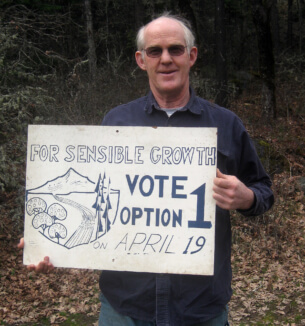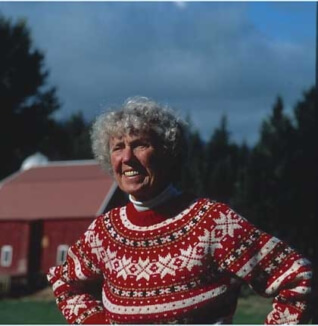40 Years and Going Strong–My memories of the early days with HRVRC
By Board President Mike McCarthy
In the Valley
My mom, Kate McCarthy, told me the legend of the April 1977 advisory ballot many times – a countywide vote between Option 1 and Option 2 that occurred at a gloomy time. Hood River’s economy looked like it could really use a boost, with a jobless rate well above Oregon’s average. Windsurfing was at least five years in the future. The Gorge National Scenic Area was ten years away.
Option 1 and Option 2 that occurred at a gloomy time. Hood River’s economy looked like it could really use a boost, with a jobless rate well above Oregon’s average. Windsurfing was at least five years in the future. The Gorge National Scenic Area was ten years away.
Forty years ago, Hood River County wasn’t thrilled about complying with Oregon’s newly passed Senate Bill 100 and Mt. Hood Meadows was already cooking up an Aspen-sized housing development to augment their newly created ski area on Mt. Hood’s north side. Nothing stood in their way except a very green Hood River Valley Residents Committee (HRVRC).
HRVRC was “Option 1” – the choice to actively preserve our resource-based community. At the beginning our group’s only mission was to teach voters that there was an alternative to Hood River County’s imposing scheme of zoning the entire upper Hood River Valley – farm and forest land – into one-acre lots. We needed to show them why that mattered, even if they lived in the cities of Hood River or Cascade Locks.
Back then, we didn’t get a lot of respect or recognition from downtown Hood River – that would come later. Local print and radio outlets pointedly advised us to “buy an ad” if we wanted to get our message to the public. So, we bought a giant billboard facing the county courthouse: “Vote Option 1 for Sensible Growth.” Then we bought a full-page ad in the paper, filled with the names of neighbors and businesses who publicly supported Option 1.
And we spoke to every local group who would have us at their meetings; we answered questions and asked for their votes. At that time, many in Hood River’s Japanese- and Mexican-American communities weren’t prepared to be lightning rods like my mom – understandably – but we counted on their crucial support.
The budding Residents Committee led by upper valley farmers Bob McIsaac, Gene Euwer, my mom Kate McCarthy, and many others, swayed a clear majority of county voters to refuse the poison apple of frosted chalet subdivisions and 36-hole destination resorts. With hindsight, we were justified to talk about how the county’s plan would be a one-way skid toward the sprawl and interchangeable malls that have overtaken formerly farmed regions like Gresham, Hillsboro and Tigard.
Our unripe group had tallied its first political and planning success – keeping intact the entire valley’s natural vistas, forests and productive farmland that we live, work, and recreate in today. Our opponents mistook us for NIMBYs and elitists, armed with torches and pitchforks against threats to the status quo. Others dismissed us as hayseeds then were surprised by our expertise in Agriculture, Business, Science, Planning and Law.
On the Mountain
 Our standing rose with our next big planning challenge.
Our standing rose with our next big planning challenge.
The Resident Committee’s second major conflict started in 1978 when Mt. Hood Meadows proposed a 450-dwelling destination resort, with a sprawling golf course, shops, gas stations and restaurant four miles south of Parkdale in the forest.
My mom tells the story of standing in her kitchen when the principals of Mt. Hood Meadows magnificently rolled out a destination resort map showing their golf course on her farm. At that point, the fight was on… they didn’t stay for dinner.
HRVRC grew stronger with this conflict and built a list of 2,500 households who’d signed our petition in opposition to the resort. Many orchardists and other citizens joined the struggle. In the fall of 1982, the 7-member Planning Commission voted down a zone change to allow the resort. A top land-use attorney and counsel for Meadows commended our group for “the quality and professionalism” of our testimony, and didn’t appeal their loss.
We were, and are today, fighting passionately for working lands that have often played second fiddle to the nation’s second home and condo juggernaut for decades. Hood River was becoming the unspoiled playground of a fast-growing metropolis – just an hour away — with its craving for farm and forestland.
Livable Communities
Today, with members and alliances beyond the Hood River Valley, we’ve still kept our sights on “Option 1” – a conscientious and constant advocate for a planned Hood River Valley with our natural assets as its hub, its economic engine and its key trait. Our mission begins: “to protect Hood River Valley’s farm and forest land and the livability of its cities and rural communities…” These early clashes cemented our belief that a watchdog group would always be needed to achieve our mission and support Oregon’s Land-Use laws. We’ve had a say in the Hood River County land-use process for that entire 40-year period. As more people have moved into Hood River we’ve pushed for urban planning that improves livability, sustainability and affordability. We’ve worked on park, transportation and port planning always with an eye to achieving what’s best long-term for the overall community.
Sure, at times the work seems “tedious,” “time-consuming,” and “wonkish” to us too. But no one can accuse us of being “against” sustainable progress, or of being anti-growth, and we’ve earned that with countless collaborations.
Celebrating 40 Years
I’d like to personally invite you to mark Hood River Valley Residents Committee’s 40th year of work with a big-time spring party. Come join us to celebrate Sunday May 21 at 3:30 to 6 pm at the Crag Rat Hut, 960 Crag Rat Road, Hood River.
At our 40th, our family is honored that we will be showing a film of my mom Kate McCarthy’s work over the last 40 years. We’re very grateful to Ralph Bloemers of Crag Law Center who created this video tribute of mom’s work including founding the Hood River Valley Residents Committee, Friends of Mt. Hood and Friends of the Gorge. By sharing her love of nature with me, I’ve been inspired to help preserve these important places into the future.
Please come help us celebrate, share our history and discuss your ideas and visions for the future of our County – and most importantly, get involved. We’ve a long and successful history of advocating to protect farm and forest land but the future of the Hood River Valley is all of ours together.